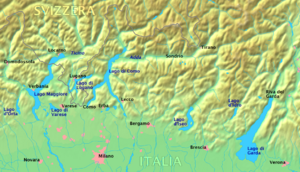البحيرات الإيطالية

البحيرات الإيطالية (إيطالية: Grandi laghi prealpini, حرفياً "البحيرات العظمى قبل الألپ") هي مجموعة من large lakes lying on the south side of the Alps, in the basin of the river Po and the Mediterranean Sea. As their name suggests, they are essentially located in northern Italy, however, they are also partly located in southern Switzerland. They are all glacial lakes that formed after the retreat of the glaciers at the end of the last ice age. The group is composed of (from west to east): بحيرة أورتا وبحيرة ماجورى وبحيرة ڤاريزى وبحيرة لوجانو وبحيرة كومو وLake Iseo, Lake Idro and Lake Garda.[1] The three largest are all well over 100 كم²، وهم: بحيرة گاردا (الأكبر في إيطاليا)، بحيرة ماجورى (الأكبر في جنوب سويسرا) وبحيرة كومو.
وتقع البحيرات في الأقاليم الإيطالية پيدمونت ولومبارديا وڤـِنـِتو و ترنتينو ألتو أديجى/جنوب التيرول، وفي الكانتون السويسري تيتشينو. They are all located at least partly in Italy, while two of them (Maggiore and Lugano) are partly in Switzerland.
The Italian Lakes constitute a popular tourist destination since the Roman Era for their mild climate and their view of the Alps.[2]
المناخ
At latitudes between 45° and 46° North and at elevations below 400 metres above sea level, the Italian Lakes enjoy a lot of sunshine and very mild weather. The region is known for its sub-Mediterranean climate, making it the warmest area of Switzerland[3] and significantly warmer than most regions of northern Italy. There sub-tropical plants can grow all year round in the numerous gardens, notably those of the Borromean and Brissago Islands. During winter, the lakes help to maintain a higher temperature in the surrounding regions (since water releases heat energy more slowly than air) with snowfalls being erratic and primarily affecting the higher elevations around the lakes. Rainfall is lowest during the winter months and heaviest around summer, peaking in spring and autumn.[4][5][6]
The particularly mild climate of the Italian Lakes favours the growth of some hardy Mediterranean plants, including the olive tree, parasol pine, mediterranean cypress, chinese windmill palm and Canary Island Date Palm. Lake Lugano (Gandria) is one of the few places in Switzerland where olives are grown. Some hardy Citrus trees, such as hardy lemons and satsuma can also be found around Lake Garda, which are extremely rare at this latitude.[7]
المراجع
- ^ Gabriel Faure (1923). The Italian Lakes: Maggiore, Como, Orta, Varese, Lugano, Iseo, Garda
- ^ "Italian Lakes". November 11, 2015 – via www.telegraph.co.uk.
- ^ Grünig, Andreas (1994). Mires and Man: Mire Conservation in a Densely Populated Country. Swiss Federal Institute for Forest, Snow and Landscape Research. p. 27. ISBN 9783905620344.
in the lowlying area of the canton Ticino, there is sub-Mediterranean climate and flora of the northern Italian lakes region
- ^ See for instance Locarno#Climate, Lugano#Climate or Como#Climate
- ^ The history of Lake Maggiore lagomaggioreonline.it. Retrieved 2010-03-12
- ^ Lake Maggiore myswitzerland.com. Retrieved 2010-03-12
- ^ Catherine Richards (2011). Lake Como, Lake Lugano, Lake Maggiore, Lake Garda - The Italian Lakes. Hunter Publishing, Inc. p. 91. ISBN 978-1-58843-770-9.